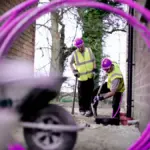Have you ever been using a device and suddenly the connection drops when you move around? You may have entered an internet dead zone.
Losing signal during a video chat or in the middle of a video game can be frustrating, but there are solutions. Read on to learn more about dead zones, how to find them and how to fix them.

What Are Internet Dead Zones?
A dead zone is a place in your home that’s supposed to get an internet connection, but for some reason, it doesn’t. When you try to connect, your device can’t find the signal, or it’s extremely weak. You may have trouble streaming movies and shows, apps may not open or load, and video chats and phone calls may drop.
Common Causes of Internet Dead Zones
Since a Wi-Fi signal travels through radio waves, it can be obstructed by various things. The waves may not be able to penetrate thick walls, bulky metal furniture like cabinets, metal walls, or plaster walls with metal wiring inside, typically found in older homes. If you and your neighbor have Wi-Fi running on the same frequency, such as 2.6GHz or 5Ghz, the two signals may interfere with each other. Connected security systems, microwaves, baby monitors and some smart home devices also use radio waves that can interfere with your Wi-Fi signal.
Signs of Internet Dead Zones
If you consistently have trouble connecting to the internet in a particular area of your home, you have found a dead zone. You can manually check for dead zones by walking through your home with a connected device and paying attention to when the Wi-Fi signal becomes weak or disconnects entirely. Another trick is to hop on a video chat from your phone and walk around your home. As soon as the video or audio is interrupted, you’re in a dead zone.
Wi-Fi Mapping Dead Zones
You can also use software to figure out where wireless dead zones exist. An app for Android devices called WiFi Analyzer creates a Wi-Fi heat map to pinpoint the exact location of the interruption. On a PC or Mac laptop, you can download a network scanner app called inSSIDer to gauge signal strength in various spots of your home.
Solutions to Eliminate Internet Dead Zones

The easiest fix is to move your router to the center of your home in an unobstructed spot, such as on top of a bookshelf. External devices can also solve the issue. A Wi-Fi repeater amplifies the signal, and an extender brings internet signal to areas your router can’t reach. These devices spread the internet signal evenly throughout your home, bringing better service to trouble spots.
The best solution is upgrading to Mesh Wi-Fi, a system with multiple access points that provides better coverage and more stable connectivity.
Preventing Internet Dead Zones in the Future
Regular maintenance of your router can go a long way in eliminating dead zones. Check that your router’s software (sometimes referred to as firmware) is up to date. You can find the latest version on your router manufacturer’s website and follow the owner’s manual instructions for guidance on completing the update. Make sure the antennas on the router are vertical, and if they’re detachable, consider replacing them with ones capable of producing a stronger signal. If your router has been used for several years, it may be time to replace the entire unit for a more consistent connection.
Trust Lumos with Your Wall-to-Wall Fiber Internet
Say goodbye to dead zones and hello to unlimited connectivity with Total Home Wi-Fi from Lumos. With our sophisticated mesh network powered by Wi-Fi 6 and 6E technology, you can work, play, stream and share from any room, no matter how many devices are connected.
Explore our fiber internet plans and call us at 888.709.0755 to discover internet built for the future.


